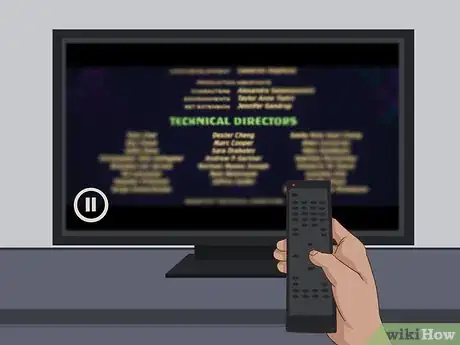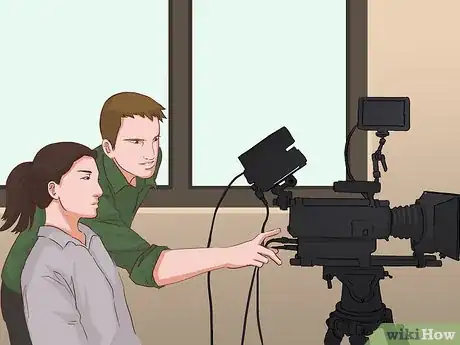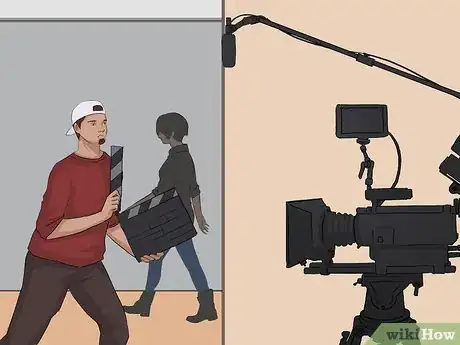This article was co-authored by Lucy V. Hay. Lucy V. Hay is an author, script editor and blogger who helps other writers through writing workshops, courses, and her blog Bang2Write. Lucy is the producer of two British thrillers and her debut crime novel, The Other Twin, is currently being adapted for the screen by Free@Last TV, makers of the Emmy-nominated Agatha Raisin.
There are 8 references cited in this article, which can be found at the bottom of the page.
This article has been viewed 57,682 times.
The terms film and movie are often used interchangeably. The word, film, though, has a slightly different meaning and is often associated with artistic expression rather than simple entertainment. As a result, appreciating the art of film is much different than simply watching films for entertainment. To appreciate the art of film you should try to experience many types of films, explore film culture, and gain a basic understanding of cinematography and the technical aspects of filmmaking.
Steps
Watching Many Types of Films
-
1View films that have been critically acclaimed. While film appreciation is more than just applauding films that critics have endorsed, critically acclaimed films are acclaimed because they are either groundbreaking or are characteristic of specific styles. Viewing critically acclaimed films, then, is a great way to hone your appreciation for film. Critically acclaimed films may include:
- Films that have won awards at the Golden Globes, the Academy Awards, the Cannes Film Festival, the Sundance Film Festival, or similar festivals and award ceremonies around the world.[1]
- Films that exemplify a certain type of filmmaking or have pioneered a genre or subject matter. To find these films, run an internet search of your favorite film style or genre, and see what comes up. Read up on that style or genre so you can identify important films.
EXPERT TIPLucy V. Hay is an author, script editor and blogger who helps other writers through writing workshops, courses, and her blog Bang2Write. Lucy is the producer of two British thrillers and her debut crime novel, The Other Twin, is currently being adapted for the screen by Free@Last TV, makers of the Emmy-nominated Agatha Raisin.Professional Writer
 Lucy V. Hay
Lucy V. Hay
Professional WriterTry jotting down notes as you're watching a movie to record your initial thoughts. For instance, if you start to lose interest, you might pause the movie and write, "At 1 hour 23 minutes in, I feel bored." You might also jot down character names, interesting or impactful scenes, snippets of dialogue, or genre and plotting conventions or twists. When the movie is over, organize those notes into a paragraph so you can revisit it later.
-
2Enjoy independent films. Independent films are films created by filmmakers not associated with major studios. These films usually have lower budgets. While their budgets may be smaller, independent filmmakers can often take on subjects and use styles that are experimental or unique. Some of the most notable independent films include:
- ’Sideways’
- ’Mean Streets’
- ’Roger and Me’
- ’Grizzly Man’
- ’City of God’[2]
Advertisement -
3Explore different genres you may otherwise ignore. A genre is a category of film. While most people are familiar with popular genres like action, drama, and horror, there are many different film genres you can explore. Some major film genres that you might overlook include:
- Biographical
- Film noir – films that portray a dark and pessimistic worldview
- Cinema verite -- a style of documentary without a narrator
- Musicals
- Silent films
- Historical films
- American "Western" films[3]
-
4Identify directors that create films you enjoy. While experiencing different genres may help you gain a wide appreciation, you may gain a lot by identifying directors that create works that move you. Ultimately, directors are largely responsible for the artistic character of a given film. Some notable directors include:
- Orson Welles, who is best known for his 'Citizen Kane'.
- Agnes Varda, who is best known for her 'Vagabond' and 'La Pointe Courte.'
- Akira Kurosawa, who is best known for his 'Rashomon' and 'The Seven Samurai'.
- Federico Fellini, who is best known for his 'La Dolce Vita' and 'Amarcord'.
- Stanley Kubrick, who is best known for his '2001: A Space Odyssey' and 'A Clockwork Orange'.
- Jane Campion, who is best known for her 'The Piano' and 'Sweetie'.[4]
Engaging Film Culture
-
1Join a film club. Attend a film club in your community. Film clubs will often sponsor screenings of different types of films. You’ll not only be able to watch films, but discuss them with other people interested in the art of film.
- You may be able to find a film club through a local college or university.
-
2Subscribe to film-related periodicals. There are a range of periodicals you can subscribe to educate yourself about films and filmmaking. These periodicals will contain reviews, and will discuss new films, film theory, and more.
- Consider subscribing to internet newsletters, internet magazines, and traditional magazines. Some examples include: 'Film Comment' (www.filmcomment.com) and 'Filmmaker Magazine' (www.filmmakermagazine.com).
-
3Visit websites devoted to film culture. Take time to run a web search for different websites on any aspect of film that might interest you. Depending on your specific taste, there may be blogs, message boards, and reddit threads on which you can engage other people with similar interests. Check out:
- Sites like www.movieforums.com.
- The message boards and user comments on the Internet Movie Database (www.imdb.com).
- Various reddits like TrueFilm, which is dedicated to in-depth discussions of film (www.reddit.com/r/TrueFilm/).
- Websites dedicated to film reviews and criticisms like www.slantmagfazine.com/film
-
4Take a course on films or filmmaking. Colleges and universities in your region likely offer several courses on film appreciation and filmmaking. By taking these courses, you’ll be able to learn about many aspects of film. In the end, you’ll gain a better appreciation for the art of film. Some courses that might be available to you include:
- Introduction to Film Criticism
- History through Film
- Introduction to Filmmaking[5]
Learning About Cinematography and More
-
1Observe different types of camera shots. Filmmakers use both static shots and dynamic shots. Static shots are camera shots where the camera remains stationary and does not alter its aim. Dynamic shots are shots where the camera is moving and changing its aim. Filmmakers use both types of shots to convey meaning and to emphasize elements of what they are filming.
- With both types of shots, the angle, point of view, and scale may vary. Pay attention to these different elements when watching different films.[6]
EXPERT TIPLucy V. Hay is an author, script editor and blogger who helps other writers through writing workshops, courses, and her blog Bang2Write. Lucy is the producer of two British thrillers and her debut crime novel, The Other Twin, is currently being adapted for the screen by Free@Last TV, makers of the Emmy-nominated Agatha Raisin.Professional Writer
 Lucy V. Hay
Lucy V. Hay
Professional WriterTo really understand a film, go in with an open mind and avoid any distractions. Try to empty your mind of all preconceptions before you watch a movie. Also, try not to talk or look at your phone during the movie, and watch it all in one sitting if you can.
-
2Pay attention to the lighting. Lighting is one of the most important parts of how filmmakers bring their stories to life. Filmmakers can use lighting to emphasize elements of what they’re shooting or to add mood to the story. There are several major types of lighting:
- Back lighting. This is when lighting comes from behind the character or object. This can be used to make something look mysterious or ominous.
- Key and fill lighting. This is lighting that is directed at a character or object.
- Under-lighting. This comes from below the character or object.
- Top lighting. This is where the lighting comes from above. It can be used to create a brighter, happier scene.
- Side lighting. This is when lighting is directed at the object from the side.[7]
-
3Listen to the sound of a film. The sound of a film can alter your perception of visuals and visual affects tremendously. As a result, your pursuit of film appreciation should be paired with a study of how filmmakers integrate sound into their work. Some things to consider are:
- The score
- Sound effects
- Lack of sound[8]
-
4Educate yourself about formalism. Formalist film is when a filmmaker focuses on aesthetics – how things look – more than the content or subject matter. Formalist filmmakers will experiment with a wide variety of things, including lighting, special effects, editing, colors, hues, and more.
- Some formalist films include: ‘Trip to the Moon’, ‘Cabinet of Dr. Caligari’, ‘The Blue Angel’, or ‘Golddiggers of 1933’
-
5Learn about realism. Realist film is when a filmmaker tries to recreate reality. Realist films will focus on set, location, and details. Realism does not lend itself to distortion or creative camera work. Realist films will often have a candid or natural appearance.
- Some realist films include: ‘Arrival of a Train’, ‘The Bicycle Thief’, ‘Breaking the Waves’, or the ‘Blair Witch Project’.
References
- ↑ http://www.therichest.com/rich-list/most-popular/top-10-most-prestigious-movie-awards-in-the-world/
- ↑ http://www.filmsite.org/independentfilms2.html
- ↑ http://guides.library.yale.edu/c.php?g=295800&p=1975072
- ↑ http://ew.com/article/1996/04/19/50-greatest-directors-and-their-100-best-movies/
- ↑ http://www.wjhsd.net/Downloads/intro_film_criticism.pdf
- ↑ https://www.utdallas.edu/atec/midori/Handouts/camera.htm#static
- ↑ http://portals.studentnet.edu.au/literacy/Minisites/SCEGGSDarlinghurstrevised/vliteracy/lighting.htm
- ↑ http://www.cheatsheet.com/entertainment/7-important-areas-to-consider-to-view-a-film-critically.html/?a=viewall








































































